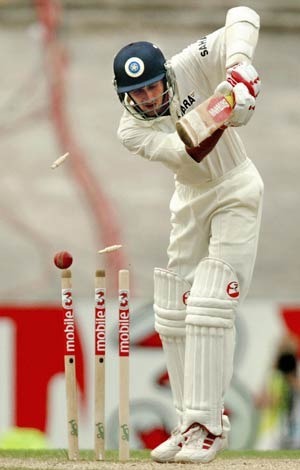Players with pairs lasting two or three balls XI

Ajit Agarkar: the man whose shrine can be found in one C Martin household
© AFP
I sat down this morning to write about the phenomenal conclusion of the Mumbai Test. However, a trawl for some tasty statistics sent me a little off-piste. I could have returned to the piste, but I did not, and I will therefore discuss the match not in this blog, but in the relaunch episode of my World Cricket Podcast, due out later this week.
Instead, I have another Confectionery Stall XI for you, arising from investigations into R Ashwin's Wankhede hundred – a historically momentous innings which means that Sachin Tendulkar and Ashwin between them have now scored 100 international centuries. No wonder the crowd went noisily berserk.
Ashwin became the fifth frontline Indian bowler this millennium to score a Test hundred, after Harbhajan (twice), Irfan Pathan, Kumble and Agarkar. In the two previous millennia, the only Indian bowler to have scored a hundred batting at No. 8 or lower was Kapil Dev, who scored two of his eight Test tons there.
Ashwin's was far from the most unexpected of these lower-order successes. Ajit Agarkar can safely claim that honour. He might have had one first-class hundred under his belt when he walked to the wicket at Lord's in 2002, but he also had nine runs in his previous six Test innings under the same belt, plus a shining belt-buckle engraved with details of a frankly heroic eight ducks in 18 Test innings to date.
Half of that quacky flock of eight ducks constituted a world-record-breaking sequence of four consecutive first-ballers in Australia in 1999-2000, a run of instantaneous ineptitude broken when he defiantly stodged out for a marathon two-ball duck in his next innings, enabling him to complete back-to-back pairs totalling five balls at the crease. It takes something special to record a King Pair. It takes something almost divine to follow it up with a three-ball pair.
At Lord's, the game was already lost, but Agarkar defied both a useful England attack and his own career average of 7.4 to plank a statistically gobsmacking 109 not out. It remained Agarkar's only Test score of more than 50. Few Test hundreds can have emerged so unexpectedly from a seemingly inescapable swamp of statistical precedent.
He later launched a similarly ingenious cricketing ambush with the ball. In the Adelaide Test of 2003-04, having lulled the Australians into a mathematically-justified sense of false baggy-green security by never having taken more than three wickets in an innings in 17 previous Tests over five years, Agarkar kebabed his way through them with 6 for 41, to set up one of India's finest victories. He never took more than three wickets in an innings again – in fact, after that series, he never took more than two wickets in a Test.
Agarkar, a consistently effective ODI performer, thus established himself as unquestionably the greatest all-round one-off-flash-in-the-pan Test player of all time: 26 Tests – one major success with the bat, one major success with the ball. Of the 41 cricketers who have converted their only Test fifty into a century, Agarkar played more than twice as many Tests as the next man on the list. And of all the bowlers who have taken 50 wickets or more in Tests, only Agarkar can claim that on the one and only occasion on which he took more than three wickets in an innings, he turned that success into a six-wicket masterclass.
Agarkar's hit-and-run Test career, and in particular his monumental, gravity-defying run of rapid-fire ducks, has inspired the Confectionery Stall Players Of My Cricket-Watching Lifetime Who Have Been Out For Pairs Lasting A Total Of Just Two Or Three Balls XI.
Published on November 28, 2011 22:28
No comments have been added yet.
Andy Zaltzman's Blog
- Andy Zaltzman's profile
- 12 followers
Andy Zaltzman isn't a Goodreads Author
(yet),
but they
do have a blog,
so here are some recent posts imported from
their feed.



